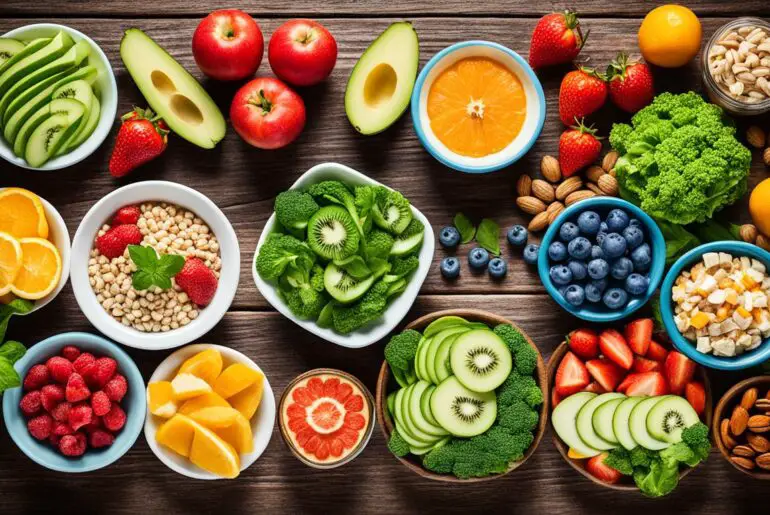Did you know that incorporating exercise during phase 2 of the HCG Diet can have a significant impact on maintaining fitness and overall well-being? Many people believe that exercise is off-limits during this phase, but that’s not entirely true. In fact, finding safe and effective ways to stay active on the HCG Diet Phase 2 can support your weight loss journey and help you maintain your energy levels.
During phase 2 of the HCG Diet, it is important to maintain a rhythm of exercise but reduce the intensity. Gentle exercise on a daily or near-daily basis is recommended. It is not advisable to start a moderate exercise regimen if you have not exercised in years. Starting with a daily 15-minute walk is a good way to create an exercise routine. However, it is important to avoid making excuses and make exercise non-negotiable to stay on track.
Taking breaks from exercise is normal, but going beyond a week without activity can lead to a reduction in cardiovascular fitness and lean muscle mass. After a break, it is possible to regain fitness levels with consistent exercise. Some helpful tips to keep exercising during phase 2 of the HCG Diet include trying gentle activities like yoga, walking, or biking, taking the stairs, trying online or on-demand workouts, and working out other muscle groups if an injury is holding you back.
Key Takeaways:
- Exercise can be safely incorporated during phase 2 of the HCG Diet.
- Gentle exercise on a daily or near-daily basis is recommended.
- Avoid making excuses and make exercise non-negotiable.
- Take breaks from exercise, but avoid going beyond a week without activity.
- Try gentle activities like yoga, walking, or biking to stay active.
Can I Exercise on the HCG Diet?
Exercise can be a valuable addition to the HCG Diet, but it’s important to approach it with caution to ensure optimal results. When combining the HCG Diet and exercise, there are potential risks to be aware of. One such risk is the potential loss of muscle mass, which can impact the metabolism and slow down weight loss progress.
Since the HCG Diet involves a low-calorie intake, it’s crucial to increase calorie intake if incorporating exercise into the routine. This helps prevent slower weight loss and provides the energy needed for workouts. Additionally, exercise on the HCG Diet can result in decreased energy levels during workouts due to the low-carbohydrate intake, which forces the body into a state called ketosis.
Before starting an exercise routine on the HCG Diet, it’s recommended to allow the body to adjust to the new eating habits. This adjustment period helps the body adapt to the restricted calorie intake before adding the stress of exercise. Giving the body time to adapt can lead to better workout performance and minimize the risk of straining the body during phase 2 of the diet.
It’s also essential to be aware that sore muscles from exercise can result in temporary weight gain due to fluid retention. This weight gain is not fat gain but rather a natural response of the body to repairing and healing muscles after physical exertion. So don’t let any temporary weight fluctuations discourage or derail your progress.
While exercise can be incorporated into the HCG Diet, it’s important to listen to your body, be mindful of its needs, and make adjustments accordingly. Each individual may have different responses to exercise, so paying attention to how your body feels and responding accordingly is key.
Exercise Recommendations for Phase 2 of the HCG Diet

During phase 2 of the HCG Diet, it is important to focus on exercises that support the body’s needs while undergoing significant changes. It is advised to avoid overdoing exercise and to steer clear of activities that raise the heart rate above 100 bpm. Instead, incorporate low-intensity exercises that promote relaxation and mindfulness.
Recommended exercises for Phase 2 of the HCG Diet:
- Going for a long walk: A brisk walk can be a great way to stay active during this phase. It helps improve blood circulation, burn calories, and maintain muscle tone without putting excessive strain on the body.
- Cycling: Engaging in a cycling routine can be a low-impact exercise option that offers cardiovascular benefits while being gentle on the joints. Whether you choose outdoor biking or a stationary bike, it can be an enjoyable way to stay active during this phase.
- Yoga exercises focused on relaxation and mindfulness: Yoga is a holistic exercise that combines stretching, strength-building, and mindfulness. During phase 2 of the HCG Diet, practicing gentle yoga exercises can help relieve stress and promote relaxation, which is crucial for overall well-being.
By incorporating these recommended exercises, you can support your body’s needs during phase 2 of the HCG Diet while nurturing relaxation and mindfulness.
Exercise Recommendations for Phase 3 of the HCG Diet
In phase 3 of the HCG Diet, also known as the stabilization phase, exercise plays an important role in maintaining overall well-being and promoting long-term fitness. With the freedom to increase the amount and intensity of physical activity during this phase, individuals have the opportunity to enhance their stamina, release stress, and boost self-confidence through exercise. However, it is crucial to approach exercise in phase 3 with a balanced and measured routine, avoiding the temptation to overdo it.
Examples of exercises that are suitable for phase 3 of the HCG Diet include group training classes, running, and hot yoga. These activities provide a mix of cardiovascular exercise, strength training, and flexibility work, allowing for a well-rounded fitness routine. However, it is important to keep in mind that exercises in this phase should not raise the heart rate to its maximum level, giving the body time to adjust after the more restricted phase 2 of the diet.
By focusing on exercises that emphasize body awareness, coordination, and mindfulness, individuals can reap the benefits of physical activity without placing undue strain on their bodies. Engaging in activities such as Pilates, tai chi, or relaxation-based yoga can help promote relaxation and help the body and mind feel refreshed during phase 3.
It is recommended to consult with a healthcare professional or a qualified fitness instructor to discuss specific exercise recommendations based on individual fitness levels, health conditions, and personal goals. Taking a gradual approach, listening to your body, and making adjustments as needed will ensure a safe and effective exercise routine during phase 3 of the HCG Diet.
Exercise Recommendations for Phase 4 of the HCG Diet

Phase 4 of the HCG Diet, also known as the maintenance phase, is an exciting time to solidify healthy habits and create a sustainable lifestyle. During this phase, incorporating high-intensity workouts can help maintain fitness levels and support long-term weight management goals. However, it is important to approach exercise with caution and gradually increase the intensity of your workouts.
Starting slowly and building up gradually is key to preventing injury and allowing your body to adjust to the increased demands. Remember, moderation is the key to success during phase 4 of the HCG Diet.
Here are some recommended exercises for Phase 4 of the HCG Diet:
- Weightlifting: Incorporating weightlifting into your workout routine can help build lean muscle mass, increase metabolism, and improve overall strength and tone. Start with light weights and focus on proper form and technique.
- Running: If you enjoy running, this is a great way to improve cardiovascular fitness and burn calories. Start with shorter distances and gradually increase the intensity and duration of your runs.
- Crossfit: Crossfit workouts are intense and versatile, combining elements of weightlifting, cardio, and high-intensity interval training (HIIT). It’s crucial to have proper guidance and start at a beginner level to avoid injury.
Remember to listen to your body and give yourself ample rest and recovery time. Overdoing it can lead to burnout or even injuries, so it’s important to find a balance between challenging workouts and rest days.
To help you plan your exercise routine during phase 4 of the HCG Diet, here’s a sample workout schedule:
| Day | Exercise |
|---|---|
| Monday | Weightlifting (upper body focus) |
| Tuesday | Running (30 minutes) |
| Wednesday | Rest day |
| Thursday | Weightlifting (lower body focus) |
| Friday | Crossfit |
| Saturday | Rest day |
| Sunday | Active recovery (yoga, stretching, or light walk) |
Remember to consult with your healthcare provider or a certified fitness professional before starting any new exercise routine, especially if you have any underlying health conditions or concerns.
Should You Exercise on the HCG Diet?
Exercising on the HCG Diet is a personal choice that should be approached with caution. While it is not mandatory, some individuals may find it beneficial for their weight loss goals. However, there are important factors to consider when incorporating exercise into your HCG Diet journey.
During phase 2 of the HCG Diet, when calorie intake is low, it is recommended to listen to your body and avoid putting it under additional stress by exercising. This phase is focused on rapid weight loss, and introducing intense exercise routines may hinder your progress. It is crucial to let your body adjust to the new diet before adding any new physical activities.
If you are already accustomed to exercising, it is advisable to decrease the intensity or shorten your workouts, especially during phase 2. Allowing your body time to recover is essential for optimal results. Remember, everyone’s body is different, and what works for one person may not work for another. It is important to determine if the combination of the HCG Diet and exercise will help you achieve your weight loss goals.
| Benefits of Exercising on the HCG Diet | Risks of Exercising on the HCG Diet |
|---|---|
|
|
Before deciding whether to incorporate exercise into your HCG Diet, it is crucial to weigh the benefits and risks. If you choose to exercise, start slowly and gradually increase the intensity as your body adjusts. Pay attention to how your body responds to exercise, and make adjustments as needed.
Remember, the ultimate goal of the HCG Diet is not just weight loss, but also creating long-term healthy habits. If exercise is part of your lifestyle beyond the diet phase, ensure you find activities you enjoy and strike a balance between challenging workouts and rest days. By making exercise a sustainable lifestyle choice, you can support your overall fitness and maintain a healthy weight.
In conclusion, exercising on the HCG Diet is a personal decision that should be approached with caution. It is not mandatory, but if you choose to exercise, it is important to do so mindfully. Prioritize letting your body adjust to the diet, consider the benefits and risks, and make adjustments as needed to support your weight loss goals.
The Benefits and Risks of Exercise on the HCG Diet

Exercise can play a crucial role in enhancing the effectiveness of the HCG Diet. It offers numerous benefits that can support weight loss and overall well-being. However, it’s important to be aware of the potential risks involved and make informed decisions about incorporating exercise into your HCG Diet journey.
The Benefits of Exercise on the HCG Diet
When done correctly, exercise can provide several advantages for those following the HCG Diet:
- Improved Cardiovascular Fitness: Regular exercise during the HCG Diet can help improve heart health, reduce the risk of cardiovascular diseases, and increase stamina.
- Increased Muscle Strength: Engaging in strength training exercises can help preserve and build muscle mass, which is crucial for maintaining a healthy metabolism.
- Stress Relief: Exercise acts as a natural stress reliever, promoting the release of endorphins that elevate mood and reduce anxiety.
- Increased Self-Confidence: Achieving fitness goals and experiencing the physical and mental benefits of exercise can boost self-confidence and motivation.
These benefits can enhance the overall experience of the HCG Diet and contribute to a more sustainable and fulfilling weight loss journey.
The Risks of Exercise on the HCG Diet
While exercise can be beneficial, there are risks to consider when combining it with the HCG Diet:
- Potential Loss of Muscle Mass: The HCG Diet involves a low-calorie intake, which can lead to muscle loss if exercise is not carefully managed. Balancing the calorie deficit with appropriate exercise and nutrition is essential to preserve muscle mass.
- Decreased Energy during Workouts: Due to the low-carbohydrate intake during the HCG Diet, the body may experience decreased energy levels during physical activity. It’s important to listen to your body and adjust the intensity and duration of workouts accordingly.
- Temporary Weight Gain due to Fluid Retention: Intense workouts can cause temporary fluid retention, leading to a temporary increase in weight. This is a normal response and should not be confused with fat gain.
Considering these risks can help you make an informed decision about incorporating exercise on the HCG Diet while minimizing any potential negative effects.
Table: Comparing the Benefits and Risks of Exercise on the HCG Diet
| Benefits | Risks |
|---|---|
| Improved cardiovascular fitness | Potential loss of muscle mass |
| Increased muscle strength | Decreased energy during workouts |
| Stress relief | Temporary weight gain due to fluid retention |
| Increased self-confidence |
Despite these potential risks, many individuals find that the benefits of incorporating exercise into their HCG Diet journey outweigh the potential drawbacks. It’s essential to assess your own goals, capabilities, and overall health when deciding whether to include exercise in your HCG Diet plan. Consulting with a healthcare professional can provide personalized guidance and ensure that your approach to exercise is safe and effective.
Listening to Your Body: Exercise During the HCG Diet
When it comes to exercise during the HCG Diet, listening to your body is key. Each person’s body responds differently to exercise, and it’s important to pay attention to its signals and adjust accordingly. Whether you’re starting a new exercise routine or continuing one during the diet, understanding your body’s response is crucial for maintaining optimal health and results.
Exercising on the HCG Diet can be both beneficial and challenging. While staying active is important for overall well-being, the low-calorie intake during phase 2 of the diet requires careful consideration. It’s essential to strike a balance between maintaining an exercise routine and allowing your body to adjust to the new dietary changes.
If you feel excessively tired or fatigued during your workouts, it might be a sign that you need to reduce the intensity or duration of your exercises. Remember, the HCG Diet is a time of low-calorie intake, so your body might require more time to recover after physical activity. By tuning in to your body’s messages, you can avoid pushing yourself too hard and risking unnecessary strain or fatigue.
After completing phase 2 of the HCG Diet, it’s important to give your body enough time to recover and adjust before increasing the intensity of your exercise routine. This is especially true if you’ve been on a very low-calorie diet during phase 2. Gradually increasing the intensity of your workouts during phase 3 and phase 4 will allow your body to adapt and ensure long-term fitness and sustainability.
Each person’s body is unique, and your response to exercise on the HCG Diet may differ from others. Paying attention to how your body reacts and making adjustments as needed is crucial for finding the right balance. Remember, the goal is to achieve overall well-being and maintain a healthy lifestyle, so listening to your body is essential every step of the way.
Making Exercise a Lifestyle Choice on the HCG Diet

Incorporating exercise into the HCG Diet can be a transformative way to embrace a long-term healthy lifestyle. By integrating regular physical activity into your daily routine, exercise becomes more than just a temporary phase of the diet—it becomes a habit that supports weight loss maintenance and overall fitness.
In order to make exercise a lasting lifestyle choice, it’s important to find activities that you enjoy. Whether it’s going for a refreshing swim, practicing yoga, or taking brisk walks in nature, choose exercises that resonate with you and bring you joy. When you engage in activities that you genuinely love, you’re more likely to stick with them and make them a consistent part of your routine.
As you progress on the HCG Diet, maintaining a balance between challenging workouts and rest days is key. Gradually increase the intensity of your workouts over time, allowing your body to adapt and improve its fitness levels. Remember to listen to your body’s cues and give yourself adequate time to recover and recharge.
“Creating healthy habits is not a one-time effort, but an ongoing commitment to your well-being. By incorporating exercise into the HCG Diet and making it a lifestyle choice, you are taking a proactive step towards long-term fitness and a healthier future.”
By creating healthy habits during the HCG Diet, you are setting yourself up for long-term success in maintaining your fitness and healthy weight. Regular exercise not only supports weight loss, but it also improves cardiovascular health, boosts mood, and enhances overall well-being. It’s not just about achieving short-term goals; it’s about embracing a lifelong commitment to your health and well-being.
| Benefits of Making Exercise a Lifestyle Choice on the HCG Diet | Risks of Neglecting Exercise on the HCG Diet |
|---|---|
|
|
Through consistent exercise and the creation of healthy habits, you can cultivate long-term fitness on the HCG Diet. Remember to choose activities that you enjoy, gradually increase intensity, and find a balance between challenging workouts and rest days. By adopting exercise as a lifestyle choice, you are investing in your long-term well-being, and reaping the rewards of improved fitness and a healthier body.
Next Steps: Sustaining Your Exercise Routine
Now that you understand the importance of exercise as a lifestyle choice on the HCG Diet, it’s time to take action. Start by identifying activities that you enjoy and that align with your fitness goals. Consider incorporating strength training, cardio exercises, and flexibility routines to create a well-rounded exercise routine.
Remember to prioritize self-care and listen to your body’s needs. If you experience any discomfort or excessive fatigue, adjust your workouts accordingly. Seek guidance from a qualified fitness professional or physician if needed.
With dedication, consistency, and a positive mindset, you can make exercise an integral part of your HCG Diet journey and experience long-term fitness and well-being.
Conclusion
Incorporating exercise during phase 2 of the HCG Diet can be a valuable addition to your weight loss journey. However, it is essential to approach it with caution and ensure you prioritize your safety and well-being. By maintaining a regular rhythm of exercise and reducing the intensity, you can stay active and reap the benefits of physical activity during this phase.
Starting with gentle activities like walking, yoga, or biking is recommended during the HCG Diet Phase 2. It is important to avoid exercises that elevate your heart rate above 100 bpm to ensure you stay within safe limits. By listening to your body and making adjustments as needed, you can maintain your fitness and overall well-being while on the HCG Diet.
As you progress into Phase 3 and Phase 4 of the HCG Diet, you can gradually increase the intensity and variety of your workouts. This allows you to explore different exercises and find what works best for you. By incorporating exercise as a long-term lifestyle choice, you can not only achieve your weight loss goals but also maintain your fitness and overall health in the long run.
FAQ
Can I exercise on the HCG Diet?
Yes, it is possible to exercise on the HCG Diet, but it should be done with caution. There are risks to consider, such as potential loss of muscle mass, decreased energy during workouts, and temporary weight gain due to fluid retention. It is important to listen to your body and adjust your exercise routine accordingly.
What are the exercise recommendations for phase 2 of the HCG Diet?
During phase 2 of the HCG Diet, it is recommended to maintain a rhythm of exercise but reduce the intensity. Gentle activities like walking, yoga, or biking are suitable options. It is important to avoid exercises that raise the heart rate above 100 bpm. Starting with a daily 15-minute walk is a good way to create an exercise routine.
What are the exercise recommendations for phase 3 of the HCG Diet?
In phase 3 of the HCG Diet, the amount and intensity of exercise can be increased. Examples of suitable exercises for this phase include group training classes, running, and hot yoga. However, it is important to start with a balanced exercise routine and not to overdo it.
What are the exercise recommendations for phase 4 of the HCG Diet?
In phase 4 of the HCG Diet, it is recommended to gradually increase the intensity of workouts. High-intensity exercises such as weightlifting, running, or Crossfit can be incorporated into the routine. Moderation is key to avoid overexertion.
Should I exercise on the HCG Diet?
Exercising on the HCG Diet is not mandatory and should be done with caution. It is important to listen to your body and not put it under additional stress, especially during phase 2 when calorie intake is low. Each person is different, and it is important to determine if the combination of the HCG Diet and exercise will help achieve your weight loss goals.
What are the benefits and risks of exercise on the HCG Diet?
The benefits of exercise on the HCG Diet include improved cardiovascular fitness, increased muscle strength, stress relief, and increased self-confidence. However, there are risks to consider, such as potential loss of muscle mass, decreased energy during workouts, and temporary weight gain due to fluid retention. It is important to weigh the benefits and risks before deciding whether to incorporate exercise into the HCG Diet.
How should I listen to my body when exercising on the HCG Diet?
It is crucial to pay attention to how your body responds to exercise and adjust accordingly. If you feel excessively tired or fatigued, it may be a sign that you need to reduce the intensity or duration of your workouts. It is also important to give your body time to recover and adjust after phase 2 before increasing the intensity of exercise. Each individual’s body will react differently, so it is important to tune in and make adjustments as needed.
How can I make exercise a lifestyle choice on the HCG Diet?
Incorporating exercise into the HCG Diet can be a way to create a long-term healthy lifestyle. It can become a habit that goes beyond the diet phase and helps maintain weight loss and overall fitness. Making exercise a lifestyle choice includes finding activities you enjoy, gradually increasing intensity, and finding a balance between challenging workouts and rest days. By creating healthy habits during the HCG Diet, you can set yourself up for long-term success in maintaining fitness and a healthy weight.




